

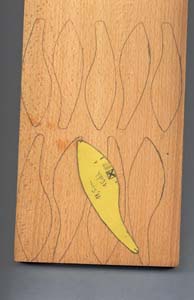
How do I build a Ludela 2 jerkbait?
Take a board of beech wood with a thickness of 15mm (I use this for the little
ludela and the 12cm version) and make sure that the grains run along the length
of the bait. For the 14cm version you should use a board of 18mm thick.
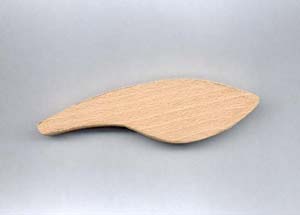
Take your stencil and draw some jerkbaits on the board. Next you have to saw
them out using a bandsaw or a handsaw.
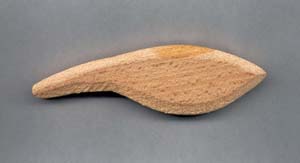
Take a wood rasp and shape the sharp edges at an angle of 45° until the surface
is 0.5cm wide. (see picture)
Use the wood rasp to complete the shaping process. Take a fine wood file to
give this jerkbait its final shape. Next you need to drill the leadhole and the
holes for the screw-eyes.
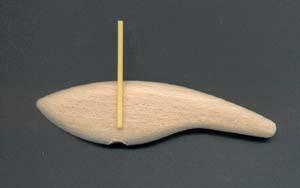 Drill the leadhole about 1.5cm deep using a drillbit of 9mm diameter if you
wish to include rattles in the bait. If you don't wish to add rattles, ony
drill the leadhole 1cm deep. The holes for the screw-eyes are drilled using a
drillbit of 1.5mm diameter.
The jerkbait is now ready to be weighted. Turn all the screw-eyes in the bait,
insert the rattles and finally add lead. Shape the lead with a pair of pliers
so it fits in the leadhole. Weight this jerkbait in such a manner that it
barely floats.
Drill the leadhole about 1.5cm deep using a drillbit of 9mm diameter if you
wish to include rattles in the bait. If you don't wish to add rattles, ony
drill the leadhole 1cm deep. The holes for the screw-eyes are drilled using a
drillbit of 1.5mm diameter.
The jerkbait is now ready to be weighted. Turn all the screw-eyes in the bait,
insert the rattles and finally add lead. Shape the lead with a pair of pliers
so it fits in the leadhole. Weight this jerkbait in such a manner that it
barely floats.
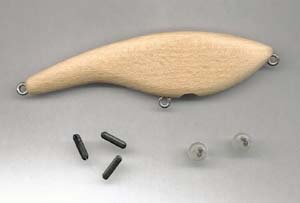
Take into consideration that beech wood soaks up water and all
th elayers of paint and lacquer have some weight which can alter the sinking
speed of the bait.
If you wish to weight this bait as a suspender, use the leader you will be
using to fish these baits. I glue the leader with duck-tape to the bait when I
weight it. This is a major factor when it comes to making suspending baits.
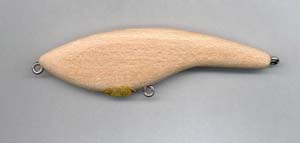
When you have weighted the jerkbait, let it dry thoroughly and fill the
remainder of the leadhole with wood-paste.
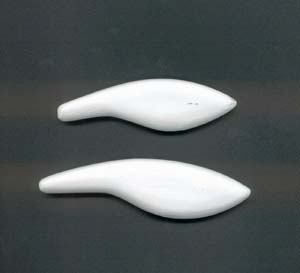
Remove the screw-eyes and sand the surface smooth using sandingpaper (grain
400).
Apply a layer of white paint (primer) and let it dry thoroughly. When it has
dried, sand it until the wooden surface shows again. There will be white spots
all over the bait which means the small holes that couldn't be sanded away will
be filled with paint. Repeat this action several times until the jerkbait's
surface is smooth and no more holes are visible.
When you have allowed this paint to dry, slightly roughen the surface with
sandingpaper.
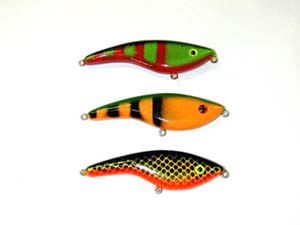
This jerkbait is now ready to be painted with your favourite
pattern.
When the spray-paint has dried, apply two layers of parket lacquer (silvatane
ITI trimetal) . I do this because if I didn't, the epoxy-lacquer I use would
react with the spraypaint. If you add some coats of epoxy lacquer to this
silvatane parket lacquer, it won't react with the spray paint.
I use Sikkens PU clearcoat for laquer. I apply at least two layers of this
Sikkens lacquer. When you have allowed the finish to harden completely, add
screw-eyes, splitrings and treble hooks. Catch a big one!
Stencils
The stencils below have the correct size. Print and use them.
The lip is not on the jerkbait. But if you add it, it turns the jerkbait into a crankbait.
The Little Ludela (9 cm)

The Ludela 2 (11,5 cm)

The Ludela 2 (14 cm)






 Drill the leadhole about 1.5cm deep using a drillbit of 9mm diameter if you
wish to include rattles in the bait. If you don't wish to add rattles, ony
drill the leadhole 1cm deep. The holes for the screw-eyes are drilled using a
drillbit of 1.5mm diameter.
The jerkbait is now ready to be weighted. Turn all the screw-eyes in the bait,
insert the rattles and finally add lead. Shape the lead with a pair of pliers
so it fits in the leadhole. Weight this jerkbait in such a manner that it
barely floats.
Drill the leadhole about 1.5cm deep using a drillbit of 9mm diameter if you
wish to include rattles in the bait. If you don't wish to add rattles, ony
drill the leadhole 1cm deep. The holes for the screw-eyes are drilled using a
drillbit of 1.5mm diameter.
The jerkbait is now ready to be weighted. Turn all the screw-eyes in the bait,
insert the rattles and finally add lead. Shape the lead with a pair of pliers
so it fits in the leadhole. Weight this jerkbait in such a manner that it
barely floats.






